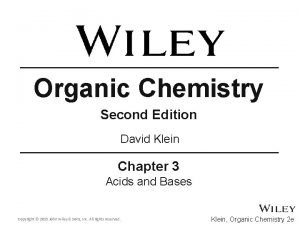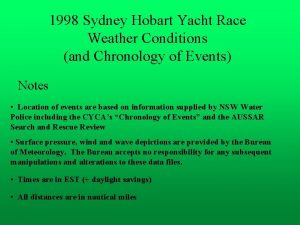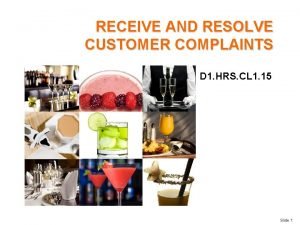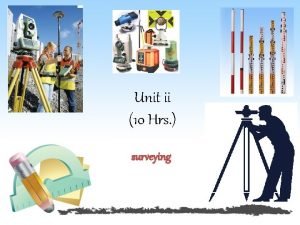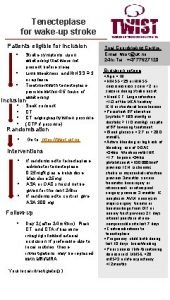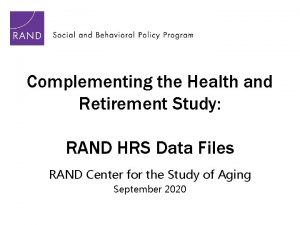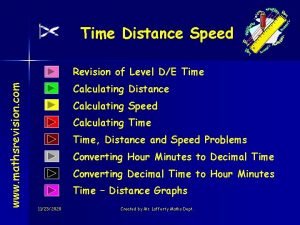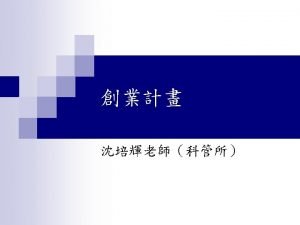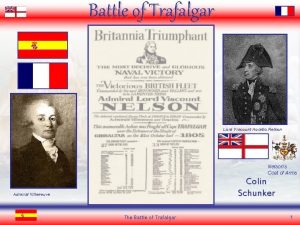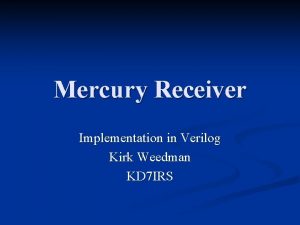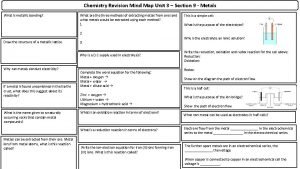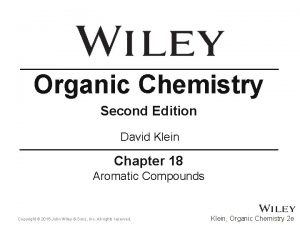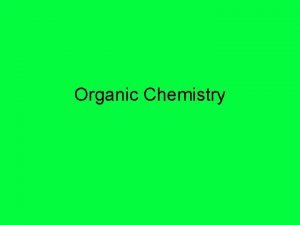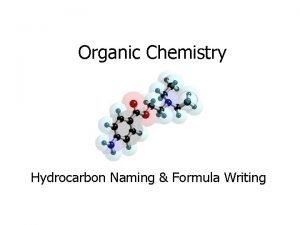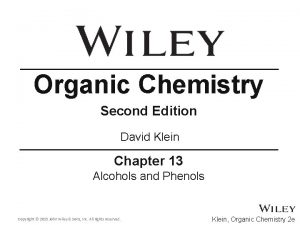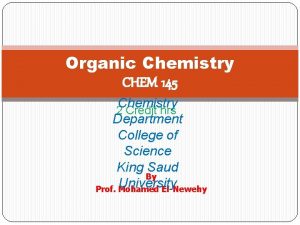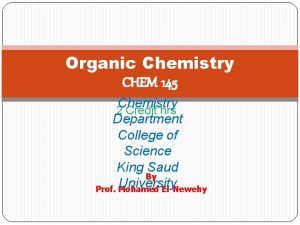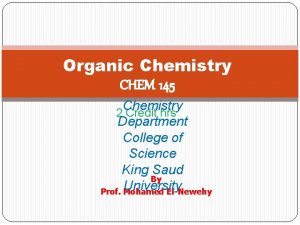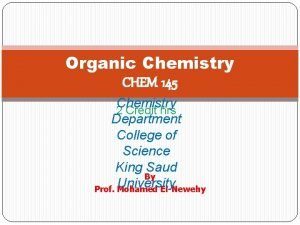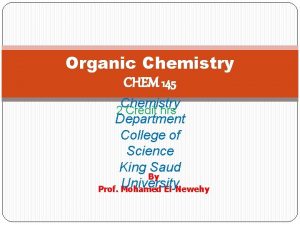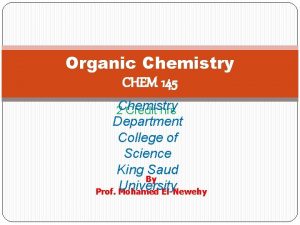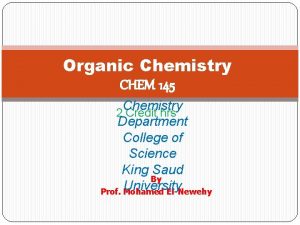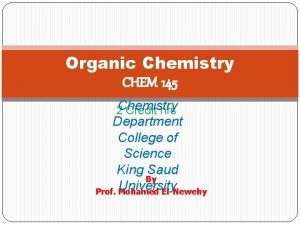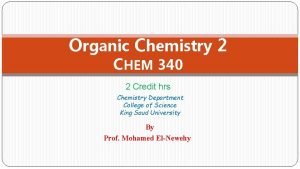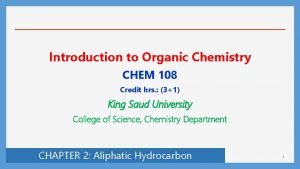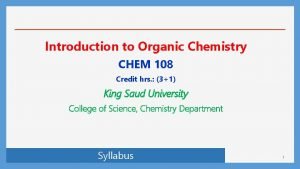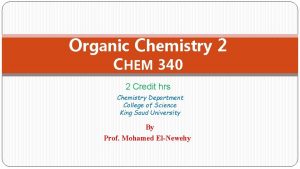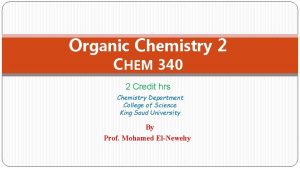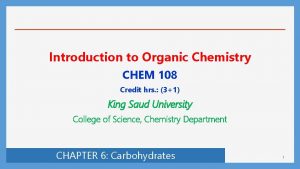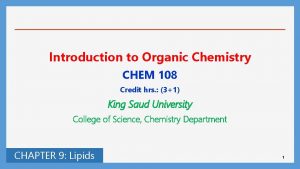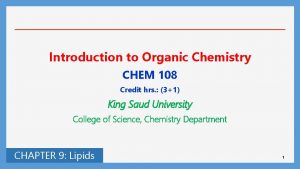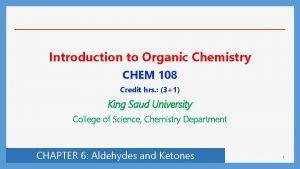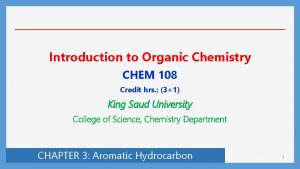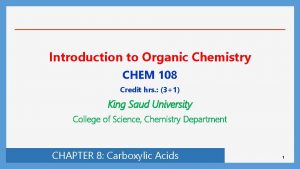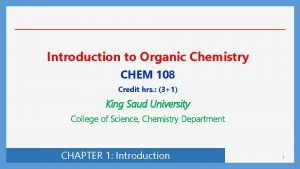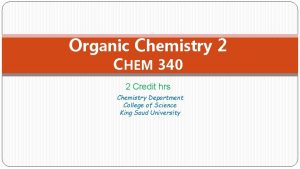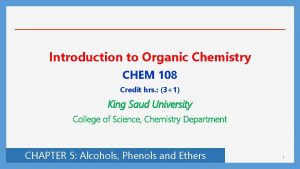Organic Chemistry CHEM 145 Chemistry 2 Credit hrs





























- Slides: 29

Organic Chemistry CHEM 145 Chemistry 2 Credit hrs Department College of Science King Saud By University Prof. Mohamed El-Newehy

Hydrocarbons

Hydrocarbon s �Hydrocarbons are Organic Compounds, which contain only the two elements carbon and hydrogen. Hydrocarbon s Aliphatic Hydrocarbo ns Saturat Alkane ed Contain carbon-carbon single s bond. Aromatic Hydrocarbo ns Unsaturat � Alkenes ed benzene-like in its properties Contain carbon-carbon double bond. �Alkynes Contain carbon-carbon triple bond.

Saturated Hydrocarbons Alkanes

�General Names n. H 2 n+2 and �C Alkanes formula is Molecular formulas of the first ten Name Methane Ethane Propane Butane Pentane Hexane Heptane Octane Nonane Decane Molecular Formula CH 4 C 2 H 6 C 3 H 8 C 4 H 10 C 5 H 12 C 6 H 14 C 7 H 16 C 8 H 18 C 9 H 20 C 10 H 22

Structural Isomerism are different �Isomers compounds with identical molecular formulas. The phenomenon is called isomerism. Structural or constitutional isomers are isomers which � differ in the sequence of atoms bonded to each other. �Examples: �Butanes, C 4 H 10. � Pentanes, C 5 H 12.

Structural Isomerism Number of Possible � Structural Isomers of Alkanes. Name Molecular Formula Methane CH 4 Ethane C 2 H 6 Propane Butane Pentane Hexane Heptane Octane Nonane Decane C 3 H 8 C 4 H 10 C 5 H 12 C 6 H 14 C 7 H 16 C 8 H 18 C 9 H 20 C 10 H 22 Number of isomers 1 1 1 2 3 5 9 18 35 75

Classes of Carbons and (1 ) carbon is one that � A primary Hydrogen is bonded to only one other carbon. � A secondary (2 ) carbon is one that is bonded to two other carbons. �A tertiary (3 ) carbon is one that is bonded to three other carbons. � Hydrogens are also referred to as 1 , 2 , or 3 according to the type of carbon they are bonded to.

Alkyl Groups alkyl group �An is an alkane from which a hydrogen has been removed. formula �General C. n. H 2 n+1 Alky group is represented by R. � �Nomenclature of alkyl groups byreplacing the suffix –ane of the parent alkane by –yl. i. e. Alkane – ane + yl = Alkyl �Examples : � Methane � Ethane CH 3 - (Methane – ane + yl) = methyl CH 3 CH 2 - (Ethane – ane + yl) =

� Propan e �Butane

The IUPAC System of Nomenclature compounds are known by two or more �Most organic names: �The older unsystematic names, (Common names). �The IUPAC names. �IUPAC: International Union of Pure & Applied Chemistry The IUPAC Rules the parent structure; the longest 1) Select continuous chain not Ethylhexane X Propylpentane the longest continuous chain is not necessarily straight.

The IUPAC Rules 2) Number the carbons in the parent chain starting from the end which gives the lowest number for the substituent 12 6 5 3 4 4 5 6 not 3 2 1 X 3 -Ethylhexan 4 -Ethylhexan e e To name the 1) compound; The position of the substituent on the parent carbon chain by a number. 2) The number is followed by a hyphen (-). 3) The combined name of the substituent (ethyl). 4) The parent (hexane) carbon chain 3 - Ethylhexane

The IUPAC 3) If. Rules the same alkyl substituent occurs more than once on the prefixes tri-, tetra-, penta-, and the parent carbondi-, chain, are usedso toon indicate two, three, four, five, and so on. 5 4 3 2 1 2, 2, 4 -Trimethylpentane 4) If different alkyl substituents are attached on the parent they are named in order of alphabetical carbon chain, order. 8 7 6 5 4 3 2 1 3, 3 -diethyl 4 -methyl 5 -n-propyl 3, 3 -Diethyl- 4 - methyl- 5 - n- octane

The IUPAC Rules 5) If substituents other than alky groups are also presents on the parent carbon chain; are named all substituents alphabetically. 5 4 3 2 1 2 - chloro 3 - bromo 4 - methyl 3 -bromo -2 - chloro - 4 -methylpentane

Physical Properties of properties that can �Those. Alkanes be observed without the compound undergoing a chemical reaction. A. Physical States occur at room temperature are gases, liquids, and Alkanes � C 1 to C 4 are solids. gases, C 5 to C 17 are liquids, C 18 and larger alkanes are wax –like solids. B. Solubility �Alkanes are nonpolar compounds. �Their solubility “ Like dissolve like” �Alkanes are soluble in the nonpolar carbon tetrachloride, CCl 4 and solvents; benzene, are insoluble in polar solvents like water. �Alkanes C. Melting Points Melting point increase with increasing molecular �

D. Boiling Points The boiling points of normal hydrocarbons increase with � increasing molecular weight. As the molecules become larger, there are more forces of attraction between them, and more energy issmall needed. For the very alkanes, the boiling point rises 20 -30°C � for each addition of a carbon atom to the chain. � Among isomeric alkanes, straight chain compound has the highest boiling point � The greater the number of branches, the lower the boiling point.

Sources of two principal �The. Alkanes sources of alkanes are petroleum and natural gas constitute the chief sources Petroleum � of Alkanes up to 40 Carbons Aromatic, Alicyclic (Cyclic aliphtic hydrocarbons) Heterocyclic Preparation of Alkanes of unsaturated 1. Hydrogenation hydrocarbon: 2. Reduction of Alkyl halides By lithium dialkyl cuprate

3. The Wurtz reaction two alkyl halides are reacted with sodium to form a new carbon-carbon bond. 2 R-X + 2 Na → R-R + 2 Na+X− 4. Hydrolysis of Grignard reagent

Notations for Bond Breaking and Bond Making A covalent bond can be broken in either two � ways, Homolytic cleavage. � �Heterolytic cleavage. Free radicals Carbocation Carboanion

Reactions of Alkanes hydrocarbons undergo very few reactions, so they �Saturated are called Paraffinic hydrocarbons. ( Latin parum, little; affinis, affinity)

Reactions of Alkanes A. Halogenation Substitution reaction of alkanes, � i. e. replacement of hydrogen by halogen, usually chlorine or bromine, giving alkyl chloride or alkyl bromide. � Flourine reacts explosively with alkanes It is unsuitable reagent for the preparation of the alkyl flourides. �Iodine is too unreactive It is not used in the halogentaion of alkanes. �Halogenation of alkanes take place at high temperatures or under the influence of ultraviolet light

�Chlorination products of an alkane usually gives a mixture of

� Both � methane and ethane give only one monochlorinated product because in each compound all hydrogen atoms are equivalent. When propane is chlorinated, two monochlorinated products; 1 -chloropropane and chloropropane. Mechanism of Halogenation of Alkanes � Proceeds by a mechanism �The 2 - free-radical chain involves three steps; 1) Chain-initiation step; Chain-propagating 2) step; 3) Chain-termination step;

1) Chain-initiation step; 2) Chain-propagating step; 3) Chain-termination step;

B. Combustion of Alkanes �When � ignited in the presence of excess oxygen, Alkanes are oxidized to Carbon dioxide and Water and heat is liberated. General equation � Examples � 160 Kcal of heat is liberated for each methylene group.

�The incomplete combustion of alkanes. liberates poisons carbon monoxide (CO) or carbon. both are major contributors to air pollution.

Cycloalkanes: are saturated hydrocarbons that exist in the form Nomenclature �Cycloalkanes of a ring. �Cycloalkanes are named by adding the prefix cyclo- to the name of the open-chain hydrocarbon. � For example; three-carbon cycloalkane is called cyclopropane. four-carbon cycloalkane called cyclobutane. � When only one substituent is attached to the ring, the substituent first and then name the ring. �If two or more substituents are attached to the ring. their positions are specified by numbers.

Ring Strain �Compounds with five- and six-membered rings were more stable than compounds with three- or four-membered rings. � In 1885, the German chemist Adolf von Baeyer proposed that the instability of three- and four-membered rings was due to angle strain. �We know that, ideally, an hybridized carbon has bond angles of 109. 5°. Baeyer suggested that the stability of a cycloalkane could be predicted by determining how close the bond angle of a planar cycloalkane is to the ideal tetrahedral bond angle of 109. 5°. The angles in an equilateral triangle are 60°. The bond angles in cyclopropane, therefore, are compressed from the ideal bond angle of 109. 5° to 60°, a 49. 5° deviation. This deviation of the bond angle from the ideal bond angle causes strain called angle strain.

Reactions of Cycloalkanes stable �Less rings �More stable 5 and 6 rings
 24 hour time
24 hour time Meth eth prop but
Meth eth prop but Induction chemistry
Induction chemistry Inorganic chemistry vs organic chemistry
Inorganic chemistry vs organic chemistry Ib chemistry organic chemistry
Ib chemistry organic chemistry Hrs
Hrs Hrs types
Hrs types Sydney to hobart 1998 wave height
Sydney to hobart 1998 wave height Hrs
Hrs Time 24 hour format
Time 24 hour format Resolve complaint
Resolve complaint Difference between rigid and flexible pavement
Difference between rigid and flexible pavement Tenecteplase stroke
Tenecteplase stroke 1900 hrs
1900 hrs Hrs rand
Hrs rand Www.mathsrevision.com
Www.mathsrevision.com Eztable taiwan
Eztable taiwan 1300 hrs
1300 hrs Bitgain 24 hrs
Bitgain 24 hrs This can be avoided by giving credit where credit is due.
This can be avoided by giving credit where credit is due. Mind map organic chemistry
Mind map organic chemistry What is organic chemistry
What is organic chemistry Organic chemistry
Organic chemistry Leveling effect organic chemistry
Leveling effect organic chemistry Organic chemistry
Organic chemistry Analytical chemistry chapters
Analytical chemistry chapters Radicals
Radicals Number of organic compounds
Number of organic compounds How to calculate percent yield
How to calculate percent yield Organic chemistry
Organic chemistry


